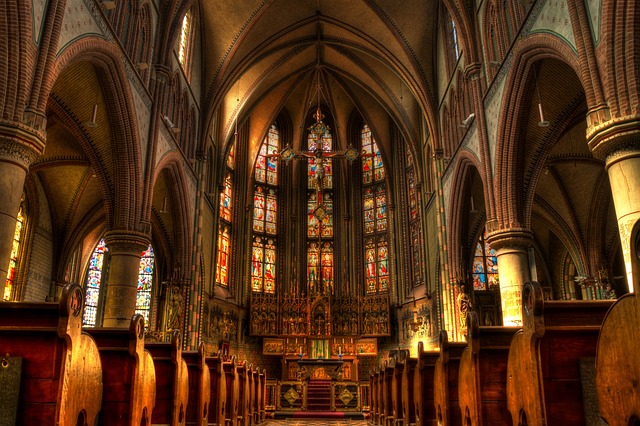Catholics do not generally practice circumcision as a religious requirement. The practice of circumcision is more commonly associated with Judaism and certain cultural traditions rather than Catholicism.
Table of Contents
The Historical Significance of Circumcision in Catholicism
Circumcision is a practice that has been followed by various cultures and religions for centuries. It involves the removal of the foreskin from the penis, usually during infancy. While it is commonly associated with Judaism, many people are surprised to learn that Catholics also practice circumcision. In this article, we will explore the historical significance of circumcision in Catholicism and shed light on why Catholics choose to circumcise their baby boys.
To understand the Catholic perspective on circumcision, we must delve into the roots of this practice. The origins of circumcision can be traced back to the Old Testament of the Bible, where it was commanded by God to Abraham as a sign of the covenant between Him and His people. This covenant was later extended to include all of Abraham’s descendants, making circumcision a sacred ritual for the Jewish community.
However, when Christianity emerged as a separate religion, the practice of circumcision became a topic of debate. The early Christian church, led by the apostles, questioned the necessity of circumcision for salvation. They believed that faith in Jesus Christ was the key to salvation, rather than adherence to Jewish customs. As a result, circumcision gradually lost its significance within the Christian community.
So why do Catholics still circumcise their baby boys? The answer lies in the historical context of Catholicism. During the Middle Ages, when the Catholic Church held immense power and influence, circumcision was seen as a way to distinguish Christians from Jews. It became a symbol of Christian identity and a rejection of Jewish customs. This practice was particularly prevalent in Europe, where anti-Semitism was rampant.
Over time, however, the Catholic Church shifted its stance on circumcision. In the 19th and 20th centuries, as the Church sought to foster better relations with other religious communities, including Judaism, the practice of circumcision lost its religious significance within Catholicism. Today, the decision to circumcise a baby boy is largely a personal choice made by Catholic parents, rather than a religious obligation.
There are various reasons why Catholic parents may choose to circumcise their baby boys. Some parents believe that circumcision promotes cleanliness and reduces the risk of certain infections. Others view it as a cultural or family tradition that they wish to uphold. Additionally, some parents may choose circumcision for aesthetic reasons, believing that it enhances the appearance of the penis.
It is important to note that the Catholic Church does not officially endorse or require circumcision. The decision to circumcise is left to the discretion of individual parents, who are encouraged to make an informed choice based on medical advice and personal beliefs. The Church emphasizes the importance of respecting the dignity and well-being of the child in all matters, including circumcision.
In conclusion, the historical significance of circumcision in Catholicism can be traced back to the Middle Ages when it served as a symbol of Christian identity. However, the practice has lost its religious significance over time, and today, it is a personal choice made by Catholic parents. Whether motivated by hygiene, tradition, or aesthetics, the decision to circumcise a baby boy is ultimately up to the parents, guided by their own beliefs and values.
Understanding the Religious Symbolism Behind Catholic Circumcision Practices

Why do Catholics circumcise baby boys? This is a question that many people have, especially those who are not familiar with Catholic traditions and practices. In order to understand the religious symbolism behind Catholic circumcision practices, it is important to delve into the history and beliefs of the Catholic Church.
Circumcision is a practice that dates back thousands of years and is rooted in various religious and cultural traditions. In the Catholic Church, circumcision is seen as a sign of the covenant between God and his people. It is believed to be a physical representation of the spiritual purification and dedication to God.
The origins of circumcision in the Catholic Church can be traced back to the Old Testament of the Bible. In the book of Genesis, God establishes a covenant with Abraham and his descendants. As a sign of this covenant, God commands Abraham to circumcise himself and all the males in his household. This act of circumcision is seen as a way to set apart God’s chosen people and to mark them as belonging to Him.
For Catholics, circumcision is not just a physical act, but also a spiritual one. It is a way for parents to consecrate their child to God and to acknowledge their role as stewards of God’s creation. By circumcising their baby boys, Catholic parents are making a public declaration of their faith and their commitment to raising their child in the Catholic tradition.
Circumcision is typically performed within the first few weeks of a baby boy’s life. The procedure is usually carried out by a trained medical professional, such as a doctor or a nurse. It is important to note that the Catholic Church does not require circumcision as a religious obligation. It is a personal choice made by parents based on their religious beliefs and cultural traditions.
While circumcision is not a requirement for Catholics, it is still a widely practiced tradition within the faith. It is seen as a way to honor the covenant between God and his people and to pass on the faith to future generations. It is also believed to have health benefits, such as reducing the risk of certain infections and diseases.
It is important to approach the topic of circumcision with sensitivity and respect. Different cultures and religions have different beliefs and practices when it comes to circumcision. It is not our place to judge or criticize these beliefs, but rather to seek understanding and promote dialogue.
In conclusion, the practice of circumcision in the Catholic Church is rooted in religious symbolism and tradition. It is seen as a way to honor the covenant between God and his people and to consecrate a child to God. While it is not a requirement for Catholics, it is a personal choice made by parents based on their faith and cultural traditions. It is important to approach this topic with respect and understanding, recognizing that different cultures and religions have different beliefs and practices.
Debunking Myths and Misconceptions Surrounding Catholic Circumcision
Why do Catholics circumcise baby boys? This is a question that often comes up when discussing the topic of circumcision within the Catholic faith. There are many myths and misconceptions surrounding this practice, and it’s important to debunk them in order to have a better understanding of why Catholics choose to circumcise their baby boys.
One common misconception is that Catholics circumcise their baby boys for religious reasons. However, this is not entirely accurate. While circumcision is a common practice among Jewish males as part of their religious tradition, it is not a requirement for Catholics. In fact, the Catholic Church does not have an official stance on circumcision, leaving the decision up to the parents.
So why do some Catholic parents choose to circumcise their baby boys? One reason is cultural or personal preference. In some cultures, circumcision is seen as a rite of passage or a way to mark a boy’s entrance into manhood. For these families, circumcision is a way to honor their cultural heritage or family traditions.
Another reason is health benefits. It is widely recognized that circumcision can have certain health benefits, such as reducing the risk of urinary tract infections, sexually transmitted infections, and penile cancer. Some parents may choose to circumcise their baby boys in order to provide them with these potential health advantages.
It’s important to note that the health benefits of circumcision are not without controversy. Some argue that the risks associated with the procedure, such as infection or complications, outweigh the potential benefits. Others believe that proper hygiene and safe sexual practices can achieve the same health outcomes without the need for circumcision. Ultimately, the decision to circumcise should be made after careful consideration of all the available information and in consultation with medical professionals.
Another myth surrounding Catholic circumcision is that it is a painful and traumatic experience for the baby. While it is true that circumcision involves a surgical procedure, steps are taken to minimize pain and discomfort for the baby. Local anesthesia is typically used to numb the area, and pain medication may be given afterwards to manage any discomfort. Additionally, the procedure is performed by trained medical professionals who prioritize the well-being of the baby.
It’s also worth noting that circumcision is not limited to Catholics. Many non-religious families also choose to circumcise their baby boys for various reasons, such as cultural or personal preferences. It is a decision that is deeply personal and should be made based on what the parents believe is in the best interest of their child.
In conclusion, Catholics circumcise baby boys for a variety of reasons, including cultural or personal preferences and potential health benefits. It is not a religious requirement within the Catholic faith, but rather a decision left up to the parents. It’s important to debunk the myths and misconceptions surrounding this practice in order to have a better understanding of why some Catholic families choose to circumcise their baby boys. Ultimately, the decision should be made after careful consideration and in consultation with medical professionals.
Exploring the Modern Perspectives on Catholic Circumcision Practices
Why do Catholics circumcise baby boys?
Circumcision is a practice that has been performed for thousands of years, and it holds significant cultural and religious importance for many communities around the world. One such community is the Catholic Church, where the circumcision of baby boys has been a longstanding tradition. In this article, we will explore the modern perspectives on Catholic circumcision practices and delve into the reasons behind this age-old ritual.
To understand why Catholics circumcise baby boys, it is essential to delve into the religious beliefs and teachings that underpin this practice. The Catholic Church views circumcision as a sign of the covenant between God and His people, a tradition that dates back to the time of Abraham in the Old Testament. According to Catholic doctrine, circumcision symbolizes purification, consecration, and the removal of sin. It is seen as a way to mark the child as a member of the faith community and to initiate them into the Church.
However, it is important to note that the Catholic Church does not consider circumcision to be a requirement for salvation or a sacrament. It is a practice that is left to the discretion of the parents, who are encouraged to make an informed decision based on their own beliefs and cultural traditions. The Church respects the autonomy of the parents and recognizes that the decision to circumcise or not is a personal one.
In recent years, there has been a shift in attitudes towards circumcision within the Catholic community. While the practice remains prevalent, there is a growing recognition of the importance of informed consent and the rights of the child. Many Catholic parents now choose to delay or forgo circumcision altogether, opting instead to let their child make the decision when they are older.
This change in perspective can be attributed to several factors. Firstly, there is a greater awareness of the potential risks and complications associated with circumcision. While the procedure is generally considered safe, there is always a small risk of infection, bleeding, or other complications. Some parents feel that it is unnecessary to subject their child to these risks when there is no medical or religious obligation to do so.
Secondly, there is a growing recognition of the importance of bodily autonomy and the rights of the child. Many argue that circumcision is a violation of a child’s right to make decisions about their own body. They believe that it is not for parents or religious institutions to decide whether or not a child should be circumcised, but rather a decision that should be made by the individual when they are old enough to understand and consent to the procedure.
Lastly, there is a broader societal shift towards questioning and reevaluating long-held traditions and practices. As our understanding of human rights and ethics evolves, so too does our approach to circumcision. Many Catholics are now engaging in open and honest discussions about the pros and cons of circumcision, weighing the religious and cultural significance against the potential risks and ethical considerations.
In conclusion, the practice of circumcising baby boys in the Catholic Church is rooted in religious tradition and symbolism. However, there is a growing recognition of the importance of informed consent and the rights of the child. Many Catholic parents are now choosing to delay or forgo circumcision, allowing their child to make the decision when they are older. This shift in perspective reflects a broader societal trend towards questioning and reevaluating long-held traditions and practices. Ultimately, the decision to circumcise or not is a personal one, guided by individual beliefs, cultural traditions, and a consideration of the child’s rights and well-being.
Conclusion
Catholics do not generally practice circumcision as a religious requirement. It is more common among Jewish and Islamic traditions.
For licensing reasons, we must provide the following notice: This content was created in part with the help of an AI.


